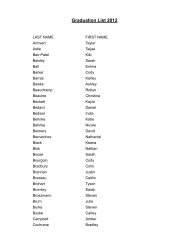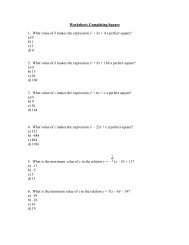The Harmonics of a Harmonica
The Harmonics of a Harmonica
The Harmonics of a Harmonica
Create successful ePaper yourself
Turn your PDF publications into a flip-book with our unique Google optimized e-Paper software.
Physics <strong>of</strong> Music<br />
Lana Johnston<br />
SPH 3U1<br />
December 2005
<strong>The</strong><br />
HARMONICA<br />
• <strong>The</strong> harmonica is a<br />
small popular musical<br />
instrument<br />
• Play by inhaling or<br />
exhaling over the mouthpiece<br />
• It is in the free reed instrument family<br />
Other Names:<br />
• Mouth harp<br />
• Mouth organ<br />
• French harp<br />
• Mississippi Saxophone<br />
• Harp
<strong>The</strong> harmonica was first made for only folk music.<br />
Now it is played with different styles <strong>of</strong> music:<br />
rock, bluegrass, blues, country, Irish, jazz,<br />
classical, etc.<br />
<strong>The</strong> earliest known harmonica was originally a wind<br />
instrument called a sheng from China. A young<br />
instrument maker discovered this about 1850 in<br />
Germany, and reconstructed it’s design. His name<br />
was Mathias Hohner.<br />
<strong>Harmonica</strong> History<br />
Hohner is the most popular brand name for the harmonica.
<strong>The</strong> HARMONICA consists <strong>of</strong><br />
<br />
<br />
many parts:<br />
<br />
<br />
<br />
<br />
Comb ~ creates holes where the player<br />
blows<br />
<br />
or draws air from, made <strong>of</strong> wood,<br />
metal or plastic<br />
Reed plates ~ flat metal plates that<br />
surround the comb<br />
<br />
Reed plate covers ~ amplifies the sound<br />
that is being made by the vibration <strong>of</strong> the<br />
reed
REEDS<br />
made <strong>of</strong> brass or bronze, which are<br />
spaced evenly and fastened at one end<br />
on the inside <strong>of</strong> the top reed plate, this<br />
leaves one end free to vibrate and create<br />
the right sound, numbers vary depending<br />
on the type <strong>of</strong> harmonica, standard<br />
harmonicas have ten, there are also<br />
some with double reeds, that are an<br />
octave apart.
<strong>Harmonica</strong> <strong>Harmonics</strong><br />
Low C is the fundamental<br />
or first harmonic (L= 1/2<br />
<strong>of</strong> wavelength)<br />
This is the second overtone<br />
or third harmonic<br />
C<br />
This C is the first overtone<br />
or second harmonic (L=<br />
wavelength)<br />
<strong>The</strong> highest C is the third<br />
overtone or fourth harmonic
THE HARMONICA<br />
• <strong>The</strong>re are notes missing<br />
in the standard diatonic<br />
harmonica so that the<br />
harmonica can have a<br />
wider range <strong>of</strong> notes<br />
• Overblowing or<br />
overdrawing is a<br />
technique that forces<br />
the reed to move faster<br />
creating a higher pitch<br />
• On a diatonic<br />
harmonica:<br />
blow: |C |E |G |C |E |G |C<br />
|E |G |C |<br />
draw: |D |G |B |D |F |A |B<br />
|D |F |A |<br />
• More notes can be<br />
played by “bending”<br />
which creates up to a<br />
semitone higher or<br />
lower then the original<br />
THE HARMONICA
<strong>Harmonica</strong><br />
An octave harmonica has two<br />
reeds per whole, they are tuned<br />
one octave apart<br />
Famous people that play the harmonica: Bob Dylan, Mick<br />
Jagger, Robert Plant, Alanis Morissette, Bruce Springsteen,<br />
Neil Young, Stevie Wonder and Mr. Pierce!!
<strong>The</strong> <strong>The</strong> Future Future <strong>of</strong> <strong>of</strong><br />
<strong>The</strong> electric harmonica is a<br />
new discovery that is<br />
improving all the time. It<br />
has an amp cover and is<br />
played the same as an<br />
“acoustic” harmonica.<br />
<strong>Harmonica</strong>s<br />
Currently a new type <strong>of</strong><br />
harmonic is being created.<br />
It is a cross between a<br />
chromatic and diatonic. It<br />
will include all chromatic<br />
notes, and will have the<br />
soul <strong>of</strong> a diatonic, being<br />
able to overblow,<br />
overdraw and bend notes.
Thanks to Physics…<br />
. . . the harmonica<br />
is one <strong>of</strong> the few<br />
instruments that<br />
allow people to<br />
express themselves<br />
freely.<br />
. . . harmonicas are<br />
known to be another<br />
voice, being able to<br />
“speak” and share<br />
ones soul with<br />
others.<br />
Thanks to Physics<br />
harmonicas are unique!
THE END<br />
THANKS FOR STAYING AWAKE!
Resources<br />
• http://www.planetharmonica.com/VE/ConseilsBPUK.htm<br />
• http://www.andrew.cmu.edu/user/antaki/articles/Bahnson%20JASA%<br />
201998.pdf<br />
• http://www.answers.com/topic/harmonica<br />
• http://images.google.ca/imgres?imgurl=http://www.musicfol<br />
k.com/images/Features/<strong>Harmonica</strong>1.jpg&imgrefurl=http://w<br />
ww.musicfolk.com/docs/Features/Feature_<strong>Harmonica</strong>.htm&h<br />
=150&w=360&sz=11&tbnid=Ovb1YA6bLlUJ:&tbnh=48&tbnw=1<br />
17&hl=en&start=32&prev=/images%3Fq%3Dharmonica%2Bm<br />
usic%2Bnotes%26start%3D20%26svnum%3D10%26hl%3Den<br />
%26lr%3D%26sa%3DN<br />
• and my dad!!




